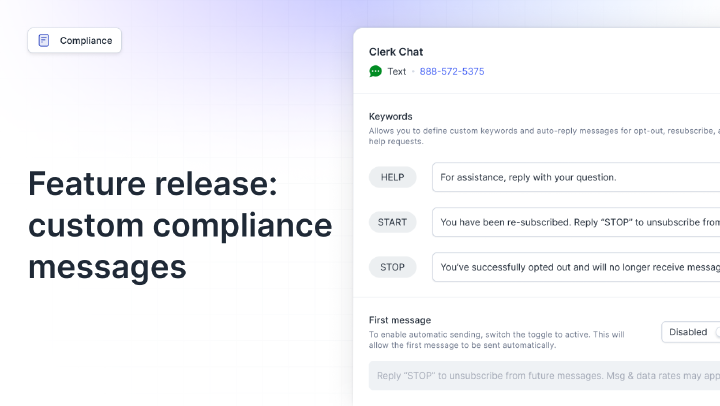SMS in Business for Marketing to Customer Support (and Beyond!)
By Team Clerk Chat
- Published: January 24, 2025
The era of SMS in business communication has officially arrived. Nearly 5 billion people (around 65% of the world’s population) use SMS to communicate. Companies aren’t just using SMS for internal interactions anymore.
Increasingly, organizations are embracing SMS as the perfect way to communicate with customers, whether they’re running SMS marketing campaigns, offering support through SMS, or simply keeping people informed with transactional alerts, notifications and updates.
That’s because SMS is quickly becoming the preferred method for customers to communicate with brands. In fact, 91% of customers say they’d like to receive texts from brands.
Here, we’ll tell you everything you need to know about texting for business communication, from its benefits and use cases, to how you can get started and which hurdles you’ll need to overcome.
In this article:
Understanding SMS for Business Communication
So, what is business messaging? Using SMS in business means leveraging text messaging as a tool for fast-paced communication. Companies can use the “short messaging service,” as well as multimedia messaging (MMS) and RCS (Rich Communication Services) to communicate internally and externally. For instance, internally, teams might use SMS to collaborate with colleagues.
Externally, companies can use a business texting service to send transactional notifications and alerts to customers, promote products through marketing campaigns, and deliver customer service.
There are various ways to approach texting for business communication. For instance, companies can use A2P messages (Application to Person), to send messages through software, automatically. A2P platforms allow companies to send quick texts to customers confirming a purchase or reservation.
Alternatively, companies could use the same automated message system to send reminders about upcoming appointments to customers, or share news about new products.
Business SMS strategies can also include person-to-person or two-way messaging, too. For instance, a company could use SMS as part of a conversational marketing campaign, where an assistant or a bot helps guide customers towards the right product.
Alternatively, organizations might use their SMS strategy to deliver fast-paced customer service, answering questions customers might have about products or addressing issues.
Have a great phone solution but you're left without texting? Learn how to use your business number for SMS, WhatsApp, and RCS.
The Technical Aspects of SMS in Business
Business messaging doesn’t have to be limited specifically to SMS. As mentioned above, companies can take advantage of MMS and RCS strategies too, with the right software. Beyond accessing the right technology, however, using SMS for business communication typically requires companies to invest in a certain type of “business number.” The common numbers used include:
Short codes: Five or six digit numbers, designed for companies that send a lot of texts to a huge number of customers quickly. They generally have a high throughput, allowing organizations to send more messages per second.
Long codes: Ten digit numbers – similar to a standard phone number. Long-code phone numbers are necessary for two-way conversations, like conversational SMS marketing campaigns and SMS customer service strategies.
Toll-free numbers: Similar to the toll-free numbers available for voice calls, toll-free numbers can also be used to send SMS messages.
10DLC numbers: 10DLC A2P numbers are a specific type of ten-digit long code number that supports higher text messaging volumes. These numbers are less likely to get flagged by spam filters, making them ideal for marketing and promotion.
The Benefits of SMS in Business
Ultimately, embracing the power of texting for business communication has a lot of benefits. First of all, virtually everyone in the modern world has a phone capable of receiving texts – so your ability to reach people is incredible. Secondly, many customers actually prefer to get texts from companies – in comparison to phone calls or emails.
Beyond that, using SMS in business means you benefit from:
- Instant engagement: SMS typically has a massive open rate, and most people read texts pretty quickly. People typically look at text notifications within five minutes of receiving one. That means you can connect with your audience faster.
- Exceptional reach: As mentioned above, everyone on the planet with a mobile phone can receive an SMS message. They don’t need to be connected to the internet (like they would with email or social media) to hear from you either.
- Scalability: With enterprise texting solutions, it’s easy to scale your messaging strategy. You can automate entire SMS campaigns, schedule messages, and even use texts for sales, marketing, and customer service. The options are endless.
Applications and Use Cases for Business SMS
We’ve already discussed some of the potential use cases of SMS for business communication – but it’s worth taking a closer look at some of the best applications for texting technology. Here are some of the top ways you can use SMS in your organization.
Internal Communications
This is an often overlooked use case for business SMS, but it’s one still worth mentioning. In today’s world of hybrid and remote work, where employees are often distributed across different locations, SMS makes it easy for everyone to stay in touch.
With the right business communication solution, you can ensure team members can connect, collaborate, and share ideas wherever they are – even if they don’t have an internet connection. Plus, some platforms even allow you to integrate your SMS tools with collaboration platforms.
For instance, with Clerk Chat, companies can link their SMS platform to Microsoft Teams and Zoom, allowing employees to send and receive messages in the channels they already use.


SMS Customer Support
Texting is an increasingly popular option for customers in search of support and guidance. In fact, around 90% of customers say they want to be able to reply to a message from a company to ask questions about products, deals, and opportunities.
With a two-way messaging service, companies can immediately respond to customer queries from anywhere, helping them to troubleshoot problems, or guiding them towards the right products. There are even platforms that allow you to create your own AI SMS assistant that can respond to common customer questions on a 24/7 basis.
Including SMS in business customer service strategies can be an excellent way to gain an edge over your competition and serve customers on the channels they use most.
SMS Marketing Strategies
With mass texting software, promoting products and services couldn’t be easier. Companies can create comprehensive, personalized campaigns promoting specific products, services, and sales to customers based on their specific preferences.
You can schedule messages to reach customers at specific times (such as just before a product launch), and include call-to-action links that drive customers back to your website. The great thing about a promotional SMS service is that you’re always going to be able to reach your customers faster and more effectively than you would on other channels.
You’re not waiting for customers to stumble onto your social media pages or website, or check their email inbox. You can immediately notify them about deals and opportunities wherever they are, boosting your chances of higher conversion rates. Companies can use promotional texts to announce flash sales, introduce new products, run limited-time offers, and even send special offers to VIPs.
Transactional Texts and Notifications
Transactional text messages and notifications are some of the best options to consider if you’re using SMS for business communication. With these messages, you’re not focused on actually “promoting” or selling products – instead, you’re sharing valuable information with customers.
You might use your SMS software to send order and purchase confirmation texts to customers or shipping updates and delivery notifications. You can use your strategy to send SMS opt-in confirmation texts, welcoming customers to your contact list.
You can even send messages to provide users with updates or notifications about product availability, changes in a service, or security alerts. Transaction texts can boost your approach to security too, allowing you to send one-time password codes to customers when they need to access an account (through two-factor authentication).
Ongoing Engagement Strategies
Using SMS in business communications is a great way to constantly connect with customers and keep them engaged. Aside from promoting new products and services, you can use your messages to highlight recent blog posts, articles, or news reports your customers might be interested in.
You could use your SMS strategy to invite customers to take part in loyalty programs, or ask for their feedback – giving you deeper insights into their preferences and needs.
Additionally, you can use an SMS reminder service to remind your customers about upcoming payment cycles, events, or appointments they might have scheduled with your team. This all leads to better relationships with customers and increased retention rates.
How to Send Business Text Messages: Best Practices
Obviously, the use cases and benefits of texting for business communication are phenomenal. However, sending business texts isn’t exactly the same as sending a text from your smartphone. You’re going to need the right software, strategy, and a deep knowledge of SMS compliance.
Here’s your best-practice guide on how to send business text messages.
Choose the Right Business SMS Platform
First, you’re going to need specific software that enables you to send messages, multi-level campaigns, and receive messages from customers in bulk. There are numerous SMS services for small businesses and enterprise users alike. Choosing the right solution requires a careful consideration of your use cases and specific needs.
Have a great phone solution but you're left without texting? Learn how to use your business number for SMS, WhatsApp, and RCS.
First, ask yourself how you’re going to be using SMS on a daily basis. Are you looking for a tool that you can use to automate sending transactional messages to customers? Do you want a solution that comes with numerous SMS business templates for marketing campaigns?
Are you going to need built-in features for SMS customer service, like the option for two-way messaging, and customer service conversational AI apps?
Other points to consider include:
- Flexibility: Does the platform allow you to choose your own carrier and access a range of numbers for texting? Does it support different types of messaging strategies?
- Reliability: How do the vendor’s SMS deliverability stats hold up under scrutiny? Can they ensure you can reach a wide range of customers with minimal issues?
- Scalability: Can the platform handle a large number of users and contacts? Does it allow you to organize contact details effectively for more personalized messaging?
- Reporting and analytics: Access to robust reporting and analytics tools can help you make better decisions about how to optimize your messaging strategies.
- Security: Does the platform have advanced security features, like end-to-end encryption for your data and access to multi-factor authentication?
Integrating Your Platform with Business Tools
One other point to consider when you’re looking for the best platform for SMS in business communication – is whether it can integrate with your existing tools. If you’re looking for a platform that’s easy for your teams to access and use, making sure that it can integrate with existing platforms, like Microsoft Teams, Salesforce, and Zoom is a good first step.
If you need to ensure you’re adhering to specific industry regulations by storing SMS conversations effectively, you’ll need to make sure your tool can integrate with archiving platforms.
Prioritizing SMS CRM integrations is important too. A platform that integrates with your Customer Relationship Management tools will make it easier for you to customize marketing campaigns and keep track of crucial data (like opt-out requests). It should also help you gather more insights about where certain leads are in the buying cycle, which can guide your sales strategy.


Collecting Contact Details and Obtaining Consent
Once you’ve found your ideal platform for SMS communications and you’ve integrated it with your existing tools, the next step is creating a “contact list.” To communicate with customers via text for marketing or sales purposes, you’ll need to obtain their consent to message them.
This ensures you’ll adhere to the rules set out for CAN-SPAM text messages and other marketing regulations. You can invite customers to opt-in to receive your messages in a variety of different ways. For instance, you could ask people to text a keyword to your business number or fill out a form with their contact details on your website.
Often, offering customers “value” in exchange for their consent works wonders. For instance, you could promise subscribers early access to sales, or a discount code for the next order. Aside from gathering “opt-in” confirmations, make sure you have a way to track opt-out requests and spam reports too. This will help you mitigate compliance issues.
Understanding Compliance
Speaking of compliance, there are more factors to think about with SMS in business communication than just obtaining consent and respecting opt-out requests. There are various rules and regulations that govern how companies can communicate with customers.
On a broad scale, you’ll need to make sure you have a TCPA compliance policy in place. This means making sure you obtain consent from customers, give them an easy way to opt-out of receiving texts, and stay up-to-date with DNC list compliance.
Depending on the specific industry you serve, there may be other regulatory guidelines you need to consider. For instance, in the healthcare space, you’ll need to ensure your messages and communication strategy align with the rules provided by HIPAA. Familiarize yourself with the rules relevant to your business and train your SMS sales team, marketing team, and customer service reps.
Creating SMS Campaigns
Finally, when you’re ready to start actively using texting for business communication with customers, you’ll need a plan for how you’re going to create your campaigns. While the best practices you follow will vary depending on the type of messages you send, there are some basic tips to keep in mind:
- Keep messages short: Avoid overwhelming your customers with too much text. SMS messages are supposed to be short and sweet. Include only the information they’re actually going to need - and nothing else.
- Show your personality: Keep things professional, but don’t be afraid to show your personality with emojis or fun terminology. You might even consider switching to MMS or RCS to send multi-media messages to your customers.
- Personalize everything: Personalization is key to building relationships with your audience. Use your customer’s name in a message with dynamic fields. Segment your contacts into groups based on their location or preferences so you can send more relevant messages.
If you’re in the B2B industry, you can find some B2B SMS marketing examples here to inspire you. In both B2B and B2C messaging strategies however, make sure you’re monitoring your results (engagement, click through rates, and feedback) so you can optimize over time.
Embrace SMS in Business Communication with Clerk Chat
SMS is a great tool for any business, whether you’re looking to enhance internal communication, improve customer service, or take your marketing and sales strategy to the next level. All you really need to get started is the right strategy and the best platform.
Clerk Chat offers the most comprehensive platform for business SMS today. With tools for multi-step automated campaigns, transactional text messaging, and two-way messaging, Clerk Chat makes it easy to embed SMS into your business strategy.
Plus, the platform integrates with the tools companies already use, like Salesforce, Zoom, and Microsoft Teams, and offers access to in-depth analytics and reports. You can even take advantage of cutting-edge AI for better personalization strategies, or 24/7 customer service.
Discover the benefits of SMS in business communication with Clerk Chat today.
In this article:
Ready to use your business number for text messaging?
Thousands of businesses are already experiencing the power of conversational messaging through SMS. Join us. Free trial and paid tiers available.
Get Started#Subscribe
Get product updates in your inbox
Tutorials, features, and Clerk Chat news delivered straight to you.




